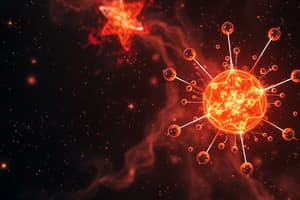Podcast
Questions and Answers
What is the primary function of buffers in the body?
What is the primary function of buffers in the body?
- To maintain pH within a narrow range. (correct)
- To produce acids in bodily fluids.
- To decrease the pH of bodily fluids.
- To increase the pH of bodily fluids.
Bicarbonate ions neutralize the blood when it becomes too basic.
Bicarbonate ions neutralize the blood when it becomes too basic.
False (B)
What two substances are found in human blood that act as a buffer system?
What two substances are found in human blood that act as a buffer system?
bicarbonate ions and carbonic acid
A pH below 7 is considered ______.
A pH below 7 is considered ______.
Match these substances with their pH levels:
Match these substances with their pH levels:
Which of the following describes a solution where [H+] < [OH-]
Which of the following describes a solution where [H+] < [OH-]
When water dissociates, it releases more hydrogen ions than hydroxide ions.
When water dissociates, it releases more hydrogen ions than hydroxide ions.
If blood becomes too basic, what substance neutralizes it?
If blood becomes too basic, what substance neutralizes it?
What is the term for the outermost electron shell?
What is the term for the outermost electron shell?
Most elements exist in nature as a single atom.
Most elements exist in nature as a single atom.
What type of bond is formed when electrons are transferred from one atom to another?
What type of bond is formed when electrons are transferred from one atom to another?
A molecule is the smallest part of a ______ that still has its properties.
A molecule is the smallest part of a ______ that still has its properties.
Which elements are involved in hydrogen bonding?
Which elements are involved in hydrogen bonding?
In a nonpolar covalent bond, electrons are shared unequally between the atoms.
In a nonpolar covalent bond, electrons are shared unequally between the atoms.
Match the bond type with their description:
Match the bond type with their description:
Organisms are composed of 70-90% ______.
Organisms are composed of 70-90% ______.
What property of water is responsible for its ability to dissolve other polar molecules or ionic compounds?
What property of water is responsible for its ability to dissolve other polar molecules or ionic compounds?
Liquid water is less dense than ice.
Liquid water is less dense than ice.
What type of bonding is responsible for water molecules clinging together?
What type of bonding is responsible for water molecules clinging together?
The movement of liquid through narrow spaces due to the attraction of the liquid's molecules to the molecules of a solid is known as ______.
The movement of liquid through narrow spaces due to the attraction of the liquid's molecules to the molecules of a solid is known as ______.
Approximately how many calories of heat energy are required to break the hydrogen bonds in water, leading to vaporization?
Approximately how many calories of heat energy are required to break the hydrogen bonds in water, leading to vaporization?
Water has a low heat capacity.
Water has a low heat capacity.
What property of water allows living things to maintain a stable internal temperature?
What property of water allows living things to maintain a stable internal temperature?
Match the following water properties with their descriptions:
Match the following water properties with their descriptions:
Flashcards
Surface Tension
Surface Tension
The ability of a liquid's surface to resist external forces, like a bug walking on water.
Why does ice float?
Why does ice float?
Water molecules form a crystal-like structure when frozen, which makes the ice less dense than liquid water.
What is an acid?
What is an acid?
A substance that releases hydrogen ions (H+) when dissolved in water. [H+] > [OH-]
What is a base?
What is a base?
Signup and view all the flashcards
What is the pH scale?
What is the pH scale?
Signup and view all the flashcards
What is a buffer?
What is a buffer?
Signup and view all the flashcards
What is Acidosis?
What is Acidosis?
Signup and view all the flashcards
What is Alkalosis?
What is Alkalosis?
Signup and view all the flashcards
Valence Shell
Valence Shell
Signup and view all the flashcards
Molecule
Molecule
Signup and view all the flashcards
Compound
Compound
Signup and view all the flashcards
Molecule of a compound
Molecule of a compound
Signup and view all the flashcards
Ionic Bonding
Ionic Bonding
Signup and view all the flashcards
Covalent Bonding
Covalent Bonding
Signup and view all the flashcards
Nonpolar Covalent Bond
Nonpolar Covalent Bond
Signup and view all the flashcards
Polar Covalent Bond
Polar Covalent Bond
Signup and view all the flashcards
Cohesion
Cohesion
Signup and view all the flashcards
High Heat Capacity
High Heat Capacity
Signup and view all the flashcards
High Heat of Vaporization
High Heat of Vaporization
Signup and view all the flashcards
Water as a Solvent
Water as a Solvent
Signup and view all the flashcards
Adhesion
Adhesion
Signup and view all the flashcards
Capillary Action
Capillary Action
Signup and view all the flashcards
Density of Water vs. Ice
Density of Water vs. Ice
Signup and view all the flashcards
Study Notes
Atoms and Elements
- Matter is anything that takes up space and has mass
- Matter is made of elements
- Elements are substances that cannot be broken down into simpler substances through ordinary chemical means
- Only 92 naturally occurring elements serve as the building blocks of all matter
- 95% of living organisms' weight is composed of six elements: carbon, hydrogen, oxygen, nitrogen, phosphorus, and sulfur
- Elements are basic to life
Organization of Living Things
- Organ: Composed of tissues that function together for a specific task
- Tissue: A group of cells with a common structure and function
- Cell: The structural and functional unit of all living things
- Molecule: A union of two or more atoms of the same or different elements
- Atom: The smallest unit of an element, composed of electrons, protons, and neutrons
Structure of an Atom
-
Electrons orbit the nucleus at particular energy levels; electron shells or orbitals
-
Valence shell: the outer electron shell
-
Most elements do not exist as single atoms in nature
-
Atom is the smallest piece of an element displaying the element's properties
-
Atomic number is the number of protons
-
Atomic mass is the sum of protons and neutrons
Molecules and Compounds
- Molecules form when two or more atoms bond together
- Compounds form when molecules consist of two or more (different) elements bond together
- Molecule: The smallest part of a compound that still has the characteristics of the compound
- Reaction: A process where two or more substances interact with each other
- Chemical reaction: Energy may be given off or absorbed
Types of Bonding
- Bonding occurs when electrons are transferred, shared, or attracted to another element, molecule, or compound
- Electrons possess energy, and the bonds between atoms also contain energy
- Organisms are directly dependent on chemical-bond energy to maintain their organization
- Types of Bonding:
- Metallic
- Ionic
- Covalent
- Nonpolar
- Polar
- Hydrogen
Ionic Bonding
- Ionic bonding occurs between a metal and a non-metal
- Ions are charged particles that form when electrons are transferred from one atom to another
- Ionic compounds are held together by an attraction between oppositely charged ions called an ionic bond
Covalent Bonding
- In covalent bonds, atoms share electrons allowing each atom to have a completed outer shell
- A covalent bond is between two non-metals
- Types of Covalent Bonds:
- Nonpolar covalent bonds: Electron sharing is equal
- Polar covalent bonds: Electron sharing is unequal
Hydrogen Bonding
- A hydrogen bond forms between a slightly positive hydrogen atom of one molecule and a slightly negative O, N or F of another molecule
Chemistry of Water
- Water is a polar molecule
- Due to hydrogen bonding, water molecules cling together
- Without hydrogen bonding: melting point (-90° C), vaporization (-100° C)
Properties of Water
- Properties of Water:
- Water is a solvent
- Water has a high heat capacity
- Water has a high heat of vaporization
- Water is cohesive
- Water is adhesive
- Water has a high surface tension
- Frozen water is less dense than liquid water
Acids and Bases
- When water ionizes, it releases an equal number of H+ and OH- ions
- Acids release H+ ions when they dissociate in water
- Bases either take up H+ ions or release OH- ions
pH Scale
- pH scale ranges from 0-14
- pH below 7 is acidic, pH above 7 is alkaline, and pH of 7 is neutral
- pH of sweat is between 4.5 and 7.0
- pH of tea varies depending on the type of tea
Buffers and pH
- A buffer is a chemical(s) that keep pH within normal limits
- In animals, the pH of body fluids is maintained within a narrow range
- The body has built-in mechanisms to prevent pH changes, and buffers are the most important of these mechanisms
- Bicarbonate ions (HCO3) and carbonic acid(H2CO3) found in human blood buffer the pH of blood to 7.4
Studying That Suits You
Use AI to generate personalized quizzes and flashcards to suit your learning preferences.




